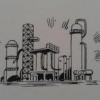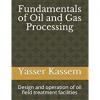I am a young process engineer and I've got a task to consider the most simple option for gas dehydration. I decided to use Eglycol and J-T expansion to dehydrate gas.
I have feed stream with the following data
T= 10 C
P= 54,72 bar.
Flow=4491 sm3/hr
Gas analysys:
Component
mol.fr.,%
CO20.771
Nitrogen
6.077
Helium
0.006
Hydrogen
0
Methane90.085
Ethane2.415
Propane0.434
і-Butane0.051
n-Butane0.094
neo-Pentane0.002
i-Pentane0.021
n-Pentane0.017
Naphthenes C50.002
i-Hexanes0.007
n-Hexane0.003
Naphthenes C60.005
Benzol0.002
i-Heptanes0.002
n-Heptane0.002
Naphthenes С70.002
Toluene0.002
The sales gas should be in accordance with 3 specifications:
1) water dew point -15 °C
2) HC dew point - 15 °C
3) Hydrate formation temperature -15 °C
4) Pressure of sales gas 25 bar
Please see PFD in attached file.
So, I used Hysys software and Peng-Robinson fluid package for my simulation and I did next:
Due to gas analysis didn't shown water in the feed stream I used Hysys saturation utility to saturate gas with water and as result I got saturated gas (Vapour fraction - 1) and at current working conditions I got:
1) HC dew point - 50 C
2) Water dew point - 10C
3) Hydrate formation temperature 10,97 C
Then I used adjust operation to find mass flowrate of glycol for reduce the hydrate formation temperature from 10,97 С to - 15 C. As result I got 1,4 kg/hr Ethylen glycol injection. Then I started to add glycol till HC dew point and Water dew point became - 15C.
For it I need to inject apr. 6 kg/hr of Ethylen glycol. Then I added J-T valve and specified pressure downstream 25 bar. Temperature of gas was reduced till - 5,5 C. And then I used 3 ph separator for separate rich glycol (Eglycol water) , NGL and sales gas.
Conclusions:
Sales gas is in accordance with design specifications, required quantity of Eglycol is apr. 6 kg/hr.
Dear colleges, Have I done all correctly? Fluid package should be PR? Do you have any comments regarding my case?
Probably you can propose another technology for my case?
Thanks a lot
Dmitry
Attached Files
Edited by Art Montemayor, 29 June 2012 - 08:40 AM.

 FB
FB











